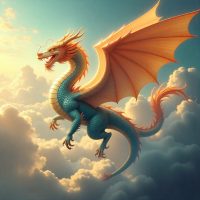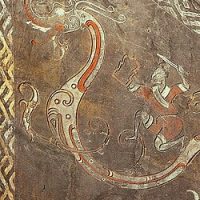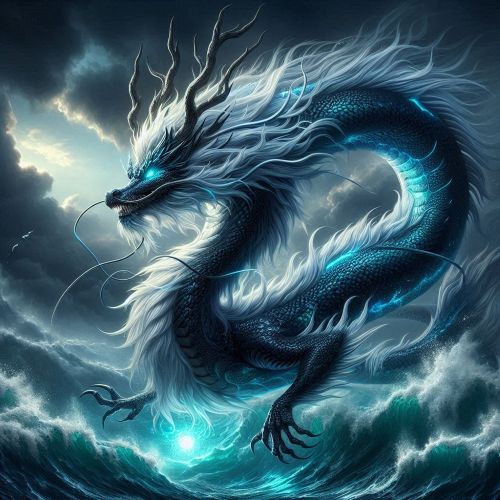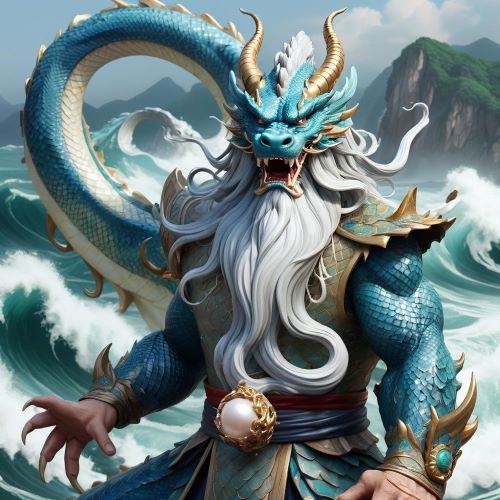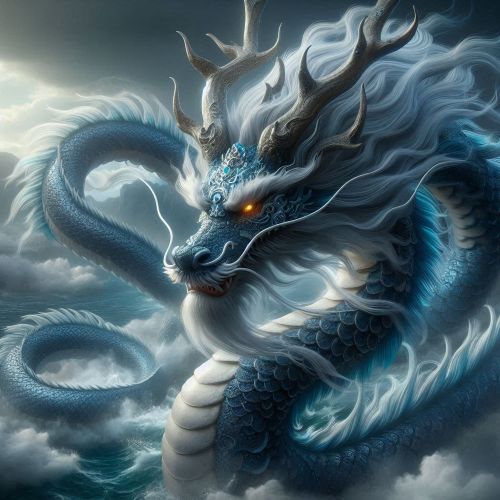Feilong : China’s Majestic Winged Dragon of the Sky
Listen
At a glance
| Description | |
|---|---|
| Origin | Chinese Mythology |
| Classification | Animals |
| Family Members | N/A |
| Region | China |
| Associated With | Sky |
Feilong
Introduction
Feilong, meaning “Flying Dragon,” is one of the most captivating celestial beings in Chinese mythology. Unlike most Chinese dragons, which weave through rivers, oceans, and mountain mists, Feilong belongs to the sky. It is a divine creature whose flight through clouds signals heavenly authority, spiritual upliftment, and harmony between the human world and the realm of the gods. Ancient texts such as the Huainanzi and early Daoist writings portray Feilong as a mystical force that appears during times of virtue, enlightenment, or cosmic balance. It is not merely a mythical animal; it is a symbol of transcendence. The presence of a Feilong was often regarded as a heavenly sign that a person possessed extraordinary spiritual merit, and Daoist sages were said to ascend to immortality by riding upon its back. Its role across mythology, symbolism, and spiritual literature cements Feilong as one of the most revered aerial beings in Chinese tradition.
Physical Traits
Feilong is visually distinct within the Chinese dragon pantheon. Traditional descriptions portray it with the head of a dragon and the tail of a phoenix, merging two of China’s most auspicious creatures into one celestial form. Its body is long, sinuous, and covered in iridescent scales that shimmer with multiple colours, making it appear almost camouflaged within drifting clouds. Unlike most Chinese dragons—which typically do not have wings—Feilong possesses elegant, feathered or cloud-like wings that glide through mist and rising vapour. This winged design sets it apart, giving it an identity more aligned with heavenly winds and the upper skies. Classical art often depicts Feilong glowing with golden, red, or azure hues as it moves through the air like a living streak of light. Its presence is described as both ethereal and powerful: a creature of divine elegance capable of commanding the forces of the heavens.
Family
Feilong does not have a fixed family lineage in the way some mythological beings do, but it exists within a network of celestial dragons and wind spirits. Some traditions connect Feilong to Yinglong—the winged dragon who assisted the Yellow Emperor in legendary battles—suggesting that Feilong may represent a specific manifestation of this ancient hero-dragon. Other interpretations link Feilong to Feilian, a wind deity with hybrid features, reinforcing its association with air, movement, and atmospheric phenomena. Although Feilong is not formally one of the Four Symbols of the cardinal directions, it is often treated as a central celestial presence complementing Qinglong, the Azure Dragon of the East. Within this larger mythological family, Feilong occupies the skyward space between divine authority and natural balance, functioning as a guardian of wind, cloud, and spiritual ascension.
Other names
The name Feilong, written as 飞龙 or 飛龍, has been adopted across East Asia, appearing in local mythologies with linguistic variations such as Hiryū in Japan, Biryong in Korea, and Philong in Vietnam. While these versions may not always correspond exactly to the Chinese Feilong, they carry the shared cultural idea of an airborne dragon representing divine power. In Chinese history, the term “Longfei” was even used as an auspicious era name during the Later Liang Dynasty, highlighting the reverence attached to the symbol. Daoist writings sometimes use Feilong as both a title and a metaphor, describing sages who “rise like a flying dragon” to enlightenment. Over centuries, it evolved from a mythological creature into a poetic and symbolic expression of speed, authority, spiritual elevation, and heavenly approval.
Powers and Abilities
Feilong is best known for its mastery of the skies. Its wings allow it to move swiftly through clouds, guiding seasonal winds and summoning life-giving rain. Ancient farmers believed that Feilong’s appearance signalled prosperous harvests, and emperors performed rituals invoking the dragon’s support to maintain natural harmony within the empire. Its connection to Daoism further enhances its role as a spiritual being: texts describe Feilong emitting harmonising sounds that mimic the “eight winds,” symbolising perfect balance between heaven and earth. It also functions as a bridge between the mortal realm and celestial spheres, guiding enlightened souls on their path to immortality. Feilong’s movements are often described as sudden and luminous, appearing like a streak of light before vanishing into the heavens—an embodiment of the mysterious, unpredictable nature of divine power.
Modern Day Influence
Feilong’s legacy thrives in modern culture across literature, games, branding, and entertainment. In martial arts, techniques inspired by Feilong emphasise fluidity, aerial movement, and explosive transitions, echoing the dragon’s agile nature. Pop culture frequently borrows the name: in Street Fighter, Fei Long is a high-speed martial artist inspired by Bruce Lee, while in Marvel Comics, Feilong appears as a technologically enhanced antagonist with overwhelming power. Contemporary Chinese fantasy novels and animated series depict Feilong as a majestic sky dragon, reinforcing its mythic grandeur for new generations. Its symbolism also appears in architecture, business names, and military insignia, representing speed, authority, and celestial protection. Even in modern branding, the name Feilong adds an air of prestige and cultural depth, proving how deeply rooted this mythical creature remains in East Asian identity and imagination.
Related Images
Source
Wikipedia contributors. (2008, November 11). Feilong. Wikipedia. https://en.wikipedia.org/wiki/Feilong
Wikiwand. (2020, December 31). Feilong. Retrieved November 2025, from https://www.wikiwand.com/en/Feilong
Wikipedia contributors. (2020, January 28). List of legendary creatures from China. Wikipedia. https://en.wikipedia.org/wiki/List_of_legendary_creatures_from_China
Tibetan Buddhist Encyclopedia. (1999, December 31). Feilong (mythology). https://tibetanbuddhistencyclopedia.com/Feilong
Birrell, A. (1993). Chinese Mythology: An Introduction. Johns Hopkins University Press.
Loewe, M., & Shaughnessy, E. L. (Eds.). (1999). The Cambridge History of Ancient China. Cambridge University Press.
Wu, K. C. (1982). The Chinese Heritage. Crown Publishers.
Schafer, E. H. (1963). The Golden Peaches of Samarkand: A Study of T’ang Exotics. University of California Press.
Yang, L. (2005). Handbook of Chinese Mythology. Oxford University Press.
Frequently Asked Questions
What is Feilong in Chinese mythology?
Feilong is a winged celestial dragon known for flying among clouds and commanding wind, rain, and spiritual forces.
Is Feilong the same as Yinglong?
They are related in some traditions, but Feilong is typically a sky-focused divine dragon, while Yinglong is a legendary warrior dragon.
Does Feilong have wings?
Yes. Unlike most Chinese dragons, Feilong is explicitly described as winged, symbolising its mastery of the heavens.
What powers does Feilong possess?
Feilong controls wind and rain, guides spiritual ascension, and represents balance between heaven and earth.
Where does Feilong appear in modern media?
Feilong features in fantasy novels, anime, games like Street Fighter, and even Marvel Comics.


